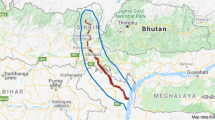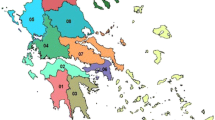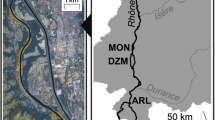Abstract
This paper examines hydro-economic aspects of the Alexander-Zeimar basin. The Alexander-Zeimar River is a transboundary river originating in the Palestinian Authority and flowing through Israel to the Mediterranean Sea. Since the 1950s, the river has been used as a sewage outlet. The major purpose of this study is to estimate the costs and benefits derived from a restoration plan, which has been in place in the river since the mid-1990s. A hydrological model combined with market and non-market valuation (travel cost method) techniques was used to estimate the condition of the situation before and after the restoration project was implemented. The total restoration plan was compared to alternative partial plans. Interestingly, a cost–benefit analysis on the different restoration options revealed that only a complete cleanup of the river results in a positive net benefit ($0.49–3.23 million annually).


Similar content being viewed by others
Notes
Other ex-post studies deal a with variety of issues, for example, Lawlor et al. (2007), Florio and Vignetti (2005), and Artis et al. (2000) analyzed water and infrastructure due to the implementation of a program; Kotchen et al. (2006) analyzed the decision to relicense two dams in Michigan; and Voorhees et al. (2000) analyzed an air pollution control program in Tokyo.
Memory can be misleading, but it was assumed to be at least as efficient as speculation. In addition, although income level and other socio-demographic variables may change, these may also change when speculating into the future. In our sample, we have concentrated only on respondents who were at least 18 years of age the year the restoration project was started.
Although memory and socio-demographic parameters may change over time.
As one referee mentioned, there might be a bias in doing so, since other socio-demographic conditions have changed and swept the restoration effect to the other direction. However, including them in the analysis increased the benefits by 1.7 %, thus not affecting much. We cannot judge whether this was actually a careless report by the respondents or a legitimate behavior so we conclude that the estimate is a lower bound in that regard.
There is no official estimation of the number of visitors. In order to get a gross estimate, the number of visitors on representative days throughout the year was sampled.
Fixed costs were amortized to annuity with a 5 % discount factor. Lowering the discount factor to 3 % would decrease the associated costs to 4.04 million US$/y and by this increase the net benefit to 3.23 million US$/y.
References
Alston JM, Larson DM (1993) Hicksian vs. Marshallian welfare: why do we do what we do? Am J Agric Econ 75:764–769
Artis M, Carrion JL, Moreno R, Pons G, Surinach J (2000) Efficiency measurements in infrastructure projects: cost-benefit analysis of the Tunnel of Cadi. Int J Transp Econ 27(3):401–423
Azevedo CD, Herriges JA, Kling CL (2003) Combining revealed and stated preferences: consistency tests and their interpretations. Am J Agric Econ 85:525–537
Banerjee T, Srivastava RK (2009) Application of water quality index for assessment of surface water quality surrounding integrated industrial estate-Pantnagar. Water Sci Technol 60(8):2041–2053
Beechie T, Pess G, Roni P, Giannico G (2008) Setting river restoration priorities: a review of approaches and a general protocol for identifying and prioritizing actions. N Am J Fish Manag 28:891–905
Bernauer T (2002) Explaining success and failure in international river management. Aquat Sci 64:1–19
Bernhardt ES, Sudduth EB, Palmer MA, Allan JD, Meyer JL, Alexander G, Follastad-Shah J, Hassett B, Jenkinson R, Lave R, Rumps J, Pagano L (2007) Restoring rivers one reach at a time: results from a survey of U.S. river restoration practitioners. Restor Ecol 15(3):482–493
Bhat MG (2003) Application of non-market valuation to the Florida Keys marine reserve management. J Environ Manage 67:315–325
Boardman A, Greenberg D, Vining A, Wiemer D (2006) Cost benefit analysis: concepts and practice, 3rd edn. Prentice Hall publishing, Upper Saddle River
Bordalo AA, Teixeira R, Wiebe WJ (2006) A water quality index applied to an international shared river basin: the case of the Douro river. Environ Manag 38(6):910–920
Bratrich C, Truffer B, Jorde K, Markard J, Meier W, Peter A, Schneider M, Wehrli B (2004) Green hydropower: a new assessment procedure for river management. River Res Appl 20:865–882
Cesario FJ (1976) Value of time in recreation benefit studies. Land Econ 51:32–41
Eiswerth ME, Englin J, Fadali E, Shaw WD (2000) The value of water levels in water-based recreation: a pooled revealed preference/contingent behavior model. Water Resour Res 36:1079–1086
Englin J, Shonkwiler JS (1995) Modeling recreation demand in the presence of unobservable travel costs: toward a travel price model. J Environ Econ Manage 29:368–377
Eom Y, Larson DM (2006) Improving environmental valuation estimates through consistent use of revealed and stated preference information. J Environ Econ Manag 52:501–516
Fedra K (2002) GIS and simulation models for water resources management: a case study of the Kelantan River, Malaysia. GIS Dev 6(8):39–43
Fedra K (2005) Water resources simulation and optimization: a web based approach. IASTED International conference on modelling, simulation, and optimization. Oranjestad, Aruba, Aug 2005, pp 250–255
Fink A (2008) How to conduct your own survey. SAGE publications, Beverly Hills
Florio M, Vignetti S (2005) Cost-benefit analysis of infrastructure projects in an enlarged European union: returns and incentives. Econ Change Restruct 38(3–4):179–210
Friedler E, Juanico M (1995) Policy of water sources and quality management in the Alexander River. In: Brandais A (ed) Master plan for the recovery of the Alexander River. Report to the Administration for the Recovery of Israeli Rivers, pp 104–133, 271–279 (Hebrew)
Guimarães MH, Sousa C, Garcia T, Dentinho T, Boski T (2011) The value of improved water quality in Guadiana estuary—a transborder application of contingent valuation methodology. Lett Spatial Resour Sci 4:31–48
Hanley N, Bell D, Alvarez-Farizo B (2003) Valuing the benefits of coastal water quality improvements using contingent and real behaviour. Environ Resour Econ 24:273–285
Haruvi N, Shalhevet S, Bachmat Y, Freeman D, Tzfati A, Harusi K (2009) Estimates of water supply with different quality levels from competing sources: application for the Hefer Valley in Israel. Geogr Netw 3(1):1–13
Hermans C, Erickson J, Noordewier T, Sheldon A, Kline M (2007) Collaborative environmental planning in river management: an application of multicriteria decision analysis in the White River Watershed in Vermont. J Environ Manag 84:534–546
Huang J, Haab TC, Whitehead JC (1997) Willingness to pay for quality improvement: should revealed and stated preference data be combined? J Environ Econ Manage 34:240–255
Huppert DD (1999) Snake River salmon recovery: quantifying the costs. Contemp Econ Policy 17(4):476–491
Israel Ministry of Health (2010) Public health regulations (wastewater effluent quality standards and wastewater treatment requirements), p 19 (Heb.)
Kotchen MJ, Moore MR, Lupi F, Rutherford ES (2006) Environmental constraints on hydropower: an ex post benefit-cost analysis of dam relicensing in Michigan. Land Econ 82(3):384–403
Lawlor J, McCarthy C, Scott S (2007) Investment in water infrastructure: findings from an economic analysis of a national programme. J Environ Plan Manag 50(1):41–63
Liou SM, Lo SL, Wang SH (2004) A generalized water quality index for Taiwan. Environ Monit Assess 96(1–3):35–52
Messner F, Zwirner O, Karkuschke M (2006) Participation in multi-criteria decision support for the resolution of a water allocation problem in the Spree River basin. Land Use Policy 23(1):63–75
Nasser AM, Zaruk N, Tenenbaum L, Netzan Y (2003) Comparative survival of cryptosporidium, coxsackievirus A9 and Escherichia coli in stream, brackish and sea waters. Water Sci Technol 47:91–96
Parparov A, Hambright KD, Hakanson L, Ostapenia A (2006) Water quality quantification: basics and implementation. Hydrobiologia 560(1):227–237
Pesce SF, Wunderlin DA (2000) Use of water quality indices to verify the impact of Cordoba City (Argentina) on Suquia River. Water Resour 34(11):2915–2926
Rosenberger RS, Loomis JB (1999) The value of ranch open space to tourists: combining observed and contingent behavior data. Growth Change 30:366–383
Schiff M, Winters LA (2002) Regional Cooperation, and the Role of International Organizations and Regional Integration. Policy Research Working Paper. World Bank, Washington
Shapira DA, Mazor G (2004) Pollutants’ concentration in Israel Rivers. Annual report. The Ministry of Environment, Jerusalem Israel
Voorhees AS, Araki S, Sakai R, Sato H (2000) An ex post cost-benefit analysis of the nitrogen dioxide air pollution control program in Tokyo. J Air Waste Manage Assoc 50(3):391–410
Wang H, Shi Y, Kim Y, Kamata T (2011) Valuing water quality improvement in China. Policy Research Working Paper # 5766, Environment and Energy team. The World Bank
Whitehead JC, Dumas CF, Herstine J, Hill J, Buerger B (2008a) Valuing beach access and width with revealed and stated preference data. Working Papers 06-15, Department of Economics, Appalachian State University
Whitehead JC, Subhrendu K, Pattanayak K, Van Houtven GL, Gelso BR (2008b) Combining revealed and stated preference data to estimate the non-market value of ecological services: an assessment of the state of the science. J Econ Surv 22:872–908
Wohl E, Angermeier PL, Bledsoe B, Kondolf GM, MacDonnell L, Merritt DM, Palmer MA, Poff NL, Tarboton D (2005) River restoration. Water Resourc Res 41:W10301. doi:10.1029/2005WR003985
Acknowledgments
This research was performed within the framework of OPTIMA (Optimization for Sustainable Water Management) and funded by the EU (Contract No. INCO-CT-2004-509091). The authors further wish to thank David Troupin from the Technion for producing the maps and Jane Morrison from McGill Univ. and Jennifer Helgeson from the London School of Economics as well as the editor and two anonymous referees for their helpful comments.
Author information
Authors and Affiliations
Corresponding author
Rights and permissions
About this article
Cite this article
Becker, N., Friedler, E. Integrated hydro-economic assessment of restoration of the Alexander-Zeimar River (Israel-Palestinian Authority). Reg Environ Change 13, 103–114 (2013). https://doi.org/10.1007/s10113-012-0318-1
Received:
Accepted:
Published:
Issue Date:
DOI: https://doi.org/10.1007/s10113-012-0318-1




